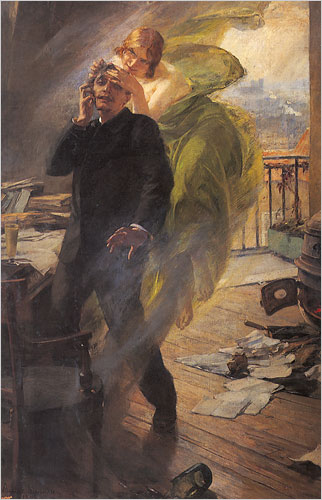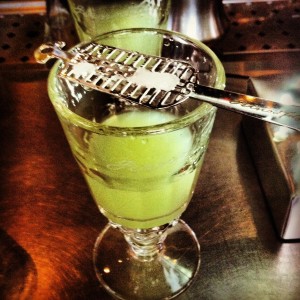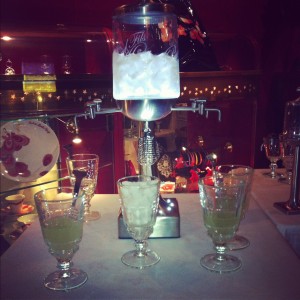Absinthe: what’s in a name
7 Jul
Fairy, goddess, muse. The personification of absinthe into a powerful female spirit speaks volumes of the spell it casts over its drinkers. To most, absinthe conjures visions of wispy, green vapor rising from a glass, translucent, sultry nymphs, and hallucinations of emerald fairies. With such eccentric connotations and a tumultuous history, one might believe that absinthe is indeed a magical, hallucinatory spirit only fit for poets or lushes.

Albert Maignan's The Green Muse
Simply enough, absinthe is the distilled maceration of plants and botanicals, much like a gin or a flavored vodka. What makes this spirit so special is its primary ingredient, wormwood, a bitter shrub with a silvery-grey sheen. The latin term for the plant is artemisia absinthium, with the word “artemisia” referring to the ancient Greek goddess Artemis, the huntress. Perhaps the once popular nickname for absinthe, “green goddess” refers to this Hellenistic goddess in particular, who is also associated with wilderness, childbirth, and curing disease, especially in women. Wormwood has indeed been used as a popular remedy for certain diseases and ailments, dating all the way back to Ancient Greece. Absinthium is a Latinized version of the ancient Greek word apsinthion, which some claim means “undrinkable” or “unenjoyable”, presumably referring to wormwood’s bitterness. Medicinally, a brewed tea of wormwood had been used to treat a broad spectrum of ailments, from headaches to labor pains. Absinthe’s popularity was sprung from similar roots, having been used as an anti-malarial for French troops stationed in Algeria.
Absinthe is classically known as popular amongst bohemian French culture; however, during its 50 year heyday during the latter part of the 19th century, it was a popular drink amongst everyone: rich and poor. Bourgeois and proletariat alike would congregate in cafes during l’heure verte, or “the green hour”, to enjoy a few glasses of absinthe. Painters, poets, and writers would drink it to induce creativity, la muse verte (the green muse) at their fingertips. The absinthe louche ritual became known to artists as unleashing the green fairy, or la fee verte. These endearing nicknames imply that there is indeed something sacred about absinthe; for there has yet to be a cognac hour or a wine fairy.
Scientifically, thujone, the predominant chemical in wormwood, is classified as a convulsant. It’s molecular makeup, however, is similar to that of THC, the essence of marijuana. Analysis has shown that in large doses, the psychoactive effects can be quite similar, however any given bottle of absinthe is almost 100% thujone-free. Chemical analyses have been performed on the other herbs that season absinthe, and have shown that in large doses, anise can provoke drunkenness, convulsions, and opium-like euphoria. Hyssop injected into rats induced convulsions. Again, the amounts of these chemicals in a bottle of absinthe are certainly negligible, although small traces of said molecules are present in every glass.
Were these essences responsible for Van Gogh’s green-tinted, halogenic paintings? Verlaine’s lurid poems? Wilde’s sardonic epigrams? There has yet to be a definitive answer, yet it is known that absinthe has been the muse for these poets and other bohemian artists of the time. A surprisingly poetic description of an absinthe stupor was posted in the American Journal of Pharmacy in 1868: “You seem to lose your feet, and you mount a boundless realm without horizon. You probably imagine that you are going in the direction of the infinite, whereas you are simply drifting into the incoherent.” Perhaps there is something inexplicably magical in absinthe, something that opens the boundaries of the mind, something that fosters creativity and self-expression. Or perhaps it’s the 140 proof alcohol mingling with the liver of its imbiber. The specific effects are better left unanalyzed and to the imagination, for as long as absinthe remains shrouded in mystery, it will continue to be a goddess, fairy, and muse.



No comments yet